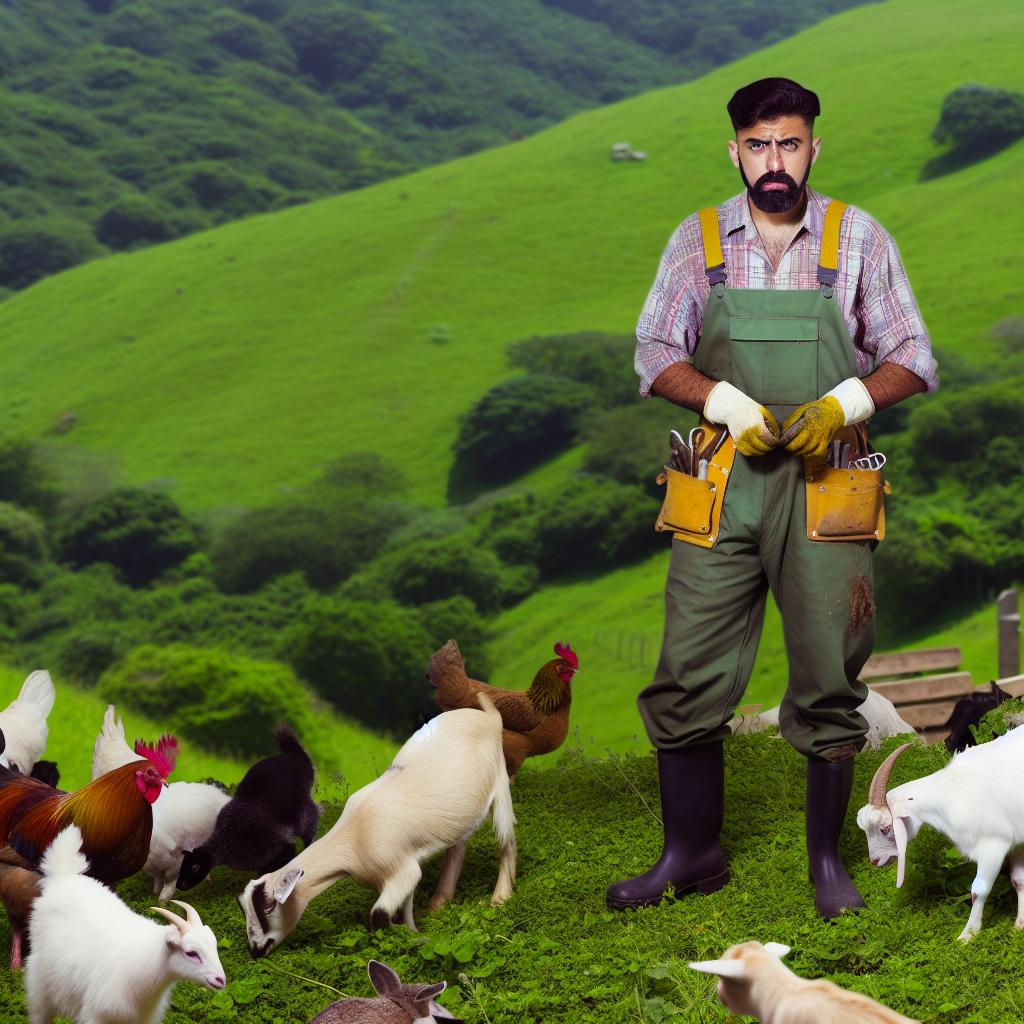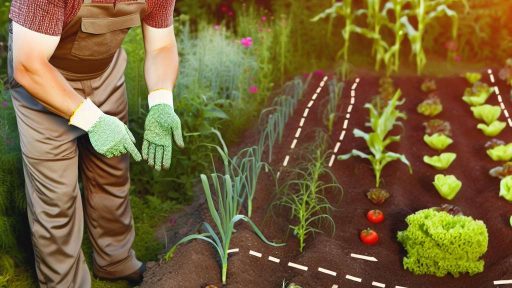Introduction to Small Livestock Management and Land Efficiency
Small livestock management plays a vital role in sustainable agriculture.
Efficient use of land leads to better resource allocation.
Farmers can maximize productivity with limited space.
The Importance of Small Livestock
Small livestock includes poultry, rabbits, and goats.
These animals require less land and resources compared to larger livestock.
They contribute to food security in urban and rural areas alike.
Enhancing Land Efficiency
Maximizing land efficiency involves strategic planning.
Multi-species grazing improves nutrient cycling in the soil.
Additionally, it reduces the risk of overgrazing.
Integrating Crop and Livestock Systems
Crops can benefit from the manure produced by small livestock.
This natural fertilizer enhances soil health and crop yields.
In turn, healthy crops provide feed for livestock.
Utilizing Space Effectively
Vertical farming techniques can optimize limited space.
For example, layers of crops can coexist with small livestock.
This arrangement maximizes production per square foot.
Transform Your Agribusiness
Unlock your farm's potential with expert advice tailored to your needs. Get actionable steps that drive real results.
Get StartedAdopting Sustainable Practices
Small livestock management promotes sustainable farming practices.
Rotational grazing prevents land degradation and promotes regrowth.
Furthermore, it can enhance biodiversity on the farm.
Challenges and Solutions
Small livestock farming faces specific challenges, such as disease management.
Investing in regular veterinary care mitigates health risks.
Additionally, education on best practices improves overall management.
Future of Small Livestock Management
As the demand for efficient food production grows, small livestock management will remain relevant.
Its capacity to enhance land efficiency makes it indispensable for future farming.
Benefits of Keeping Small Livestock for Sustainable Farming
Enhancing Soil Fertility
Small livestock contribute to soil health through natural fertilization.
Their manure enriches the soil with essential nutrients.
Moreover, this practice reduces the need for chemical fertilizers.
Effective Land Utilization
Small livestock can graze on land that may be unsuitable for larger animals.
This maximizes the productivity of available land.
Additionally, diverse species improve the overall ecosystem balance.
Reducing Pest Populations
Keeping small livestock can naturally control pests in the garden.
Chickens, for example, eat insects and larvae.
As a result, you will need fewer chemical pesticides.
Supporting Biodiversity
Small livestock breeds can enhance farm biodiversity.
They offer genetic diversity vital for resilient food systems.
Furthermore, diversified livestock helps maintain ecological balance.
Increasing Food Security
Small livestock are often easier and cheaper to raise.
They provide a reliable source of meat, eggs, and dairy.
This practice enhances food security in local communities.
Fostering Sustainable Practices
Small livestock require fewer resources compared to larger animals.
Showcase Your Farming Business
Publish your professional farming services profile on our blog for a one-time fee of $200 and reach a dedicated audience of farmers and agribusiness owners.
Publish Your ProfileThis leads to lower overall carbon footprints in farming.
Moreover, they can thrive on leftover food scraps, reducing waste.
Selection of Small Livestock: Choosing the Right Species for Your Land
Assessing Available Resources
Begin by evaluating the resources available on your land.
Consider factors such as space, water access, and feed availability.
These elements heavily influence the types of livestock you can raise.
Evaluate your budget to determine what you can afford.
Finally, analyze local zoning laws that may restrict certain livestock.
Understanding Different Species
Each species of small livestock has unique needs and benefits.
Goats are excellent for brush control and milk production.
Various chicken breeds provide eggs and meat in different quantities.
Rabbits offer high fertility rates and low maintenance costs.
Quail are space-efficient with a quick turnaround for meat and eggs.
Matching Species to Your Goals
Your intended purpose for raising livestock is crucial.
If you seek meat production, consider chickens, rabbits, or goats.
For egg production, layers are an obvious choice among chickens.
Additionally, using livestock for land maintenance can be beneficial.
Each type serves different roles that align with specific goals.
Considering Climate and Environment
Your local climate significantly impacts livestock selection.
Choose animals that thrive in your environmental conditions.
For instance, goats are adaptable and can tolerate arid climates.
Chickens often fare well in various climates but require shelter.
Climate-appropriate choices lead to healthier livestock and better yields.
Integrating Small Livestock into Farming Systems
Small livestock can coexist harmoniously in diverse farming systems.
Consider the benefits of rotational grazing to enhance soil health.
Animals can help control pests naturally while fertilizing the land.
Integrating them into crop rotations maximizes output and reduces labor.
A well-planned system fosters sustainable land management practices.
You Might Also Like: How Beekeeping Contributes to Sustainable Agriculture in the USA
Feeding Strategies for Small Livestock to Optimize Land Use
Understanding Nutritional Needs
Every small livestock species has distinct nutritional requirements.
Understanding these needs helps in formulating effective feeding plans.
For instance, goats require different minerals compared to sheep.
Additionally, chickens need specific protein levels for optimal growth.
Utilizing Forage Efficiently
Forage management plays a critical role in feeding small livestock.
Rotational grazing mitigates overgrazing and promotes pasture recovery.
This practice enhances soil health and maximizes land productivity.
Moreover, incorporating diverse plant species provides better nutrition.
Implementing Supplementation Strategies
Supplementation helps address nutritional gaps in forage.
Mineral blocks provide essential nutrients to livestock daily.
Such supplements ensure animals remain healthy and productive.
Supplementation also aids in improving overall livestock performance.
Showcase Your Farming Business
Publish your professional farming services profile on our blog for a one-time fee of $200 and reach a dedicated audience of farmers and agribusiness owners.
Publish Your ProfileTiming and Frequency of Feeding
Establishing a regular feeding schedule supports animal well-being.
Frequent, smaller meals may be beneficial for some livestock.
This approach can enhance digestion and nutrient absorption effectively.
Ultimately, timing can impact growth rates and reproductive success.
Monitoring and Adjusting Diets
Regularly assessing livestock health is vital for dietary adjustments.
Farmers should observe weight changes and overall vitality.
Such observations guide necessary alterations in feeding practices.
Furthermore, varying climates may influence forage quality and quantity.
Leveraging Local Feed Resources
Using locally available feed reduces costs significantly.
Farmers can source grains and organic matter from nearby agricultural activities.
Additionally, incorporating food waste can decrease overall feed expenses.
This practice promotes sustainability within the local agricultural ecosystem.
Engaging with Agricultural Experts
Collaborating with livestock nutritionists offers invaluable insights.
Experts can assist in developing custom feeding programs tailored to needs.
Furthermore, they provide updates on the latest research and best practices.
Building relationships ensures access to ongoing support and information.
See Related Content: DIY Garden Projects for Homesteading Beginners
Breeding Practices for Small Livestock
Importance of Selective Breeding
Selective breeding enhances livestock productivity and health.
This practice focuses on choosing animals with the best traits.
Breeders aim for desirable characteristics, such as growth rate and fertility.
Moreover, selective breeding can improve disease resistance.
Consequently, the overall resilience of the herd increases.
Understanding Genetic Diversity
Maintaining genetic diversity is crucial for livestock sustainability.
Genetic diversity helps prevent inbreeding and its associated risks.
Breeders should introduce new genetics periodically to the herd.
This introduction enhances vigor and adaptability in changing environments.
It also ensures the long-term viability of livestock populations.
Utilizing Crossbreeding Techniques
Crossbreeding combines traits from different breeds effectively.
This technique can produce hybrid vigor, resulting in healthier animals.
Farmers can select crossbreeds that best suit their specific environment.
Furthermore, it can lead to higher productivity levels in offspring.
Careful selection of parents maximizes the benefits of crossbreeding.
Implementing Record Keeping
Thorough record keeping is essential for effective breeding management.
Records help track lineage, health, and performance of animals.
This data supports informed breeding decisions over time.
Moreover, it allows farmers to identify and phase out less productive animals.
Ultimately, proper documentation enhances breeding program outcomes.
Educating and Training Breeders
Continuous education for breeders improves management practices.
Workshops and webinars provide valuable insights into modern techniques.
Networking with experienced breeders fosters knowledge exchange.
Showcase Your Farming Business
Publish your professional farming services profile on our blog for a one-time fee of $200 and reach a dedicated audience of farmers and agribusiness owners.
Publish Your ProfileFurthermore, staying informed on the latest research is crucial.
Effective training programs lead to higher efficiency in breeding.
You Might Also Like: Step-By-Step DIY Garden Projects To Enhance Soil Health For Farming In The USA

Integrating Small Livestock with Crop Production for Improved Land Efficiency
Benefits of Small Livestock in Crop Systems
Small livestock, such as chickens and goats, enhance crop production efficiency.
They provide natural fertilizers through manure, enriching the soil.
Additionally, they help control pests by consuming insects and weeds.
This integration fosters biodiversity on the farm.
Choosing the Right Small Livestock
Selecting appropriate livestock is essential for successful integration.
- Chickens are excellent for pest control while also providing eggs.
- Goats can clear underbrush, making land more usable.
- Rabbits provide meat and can be raised in small spaces.
Creating a Sustainable System
Designing a sustainable system maximizes benefits from both crops and livestock.
Sequential grazing helps avoid overgrazing and compacts the soil less.
Rotating livestock between different crop areas can maintain soil health.
This approach prevents diseases and promotes nutrient cycling.
Implementing Integrated Management Practices
Integrated management practices are crucial for success.
- Develop a schedule for rotating livestock through different fields.
- Apply timing to minimize crop damage while maximizing benefits.
- Monitor soil health to guide crop planting times effectively.
Utilizing Technology for Efficiency
Technology can streamline livestock management processes.
Farm management software helps track livestock health and productivity.
Using sensors can monitor soil moisture levels and optimize irrigation.
Such tools increase efficiency and reduce resource wastage.
Building Community Support
Engaging with local farming communities enhances knowledge sharing.
Participating in workshops can provide practical insights into best practices.
Community support fosters collaboration and resource sharing.
This collective effort leads to improved sustainability in agriculture.
Delve into the Subject: Small Livestock Management for Profitable Small-Scale Farming
Common Challenges in Small Livestock Management and Solutions
Resource Limitations
Small livestock management often encounters resource limitations.
Insufficient food and water can hinder animal health and productivity.
Additionally, limited land can restrict grazing and movement.
To mitigate these effects, consider rotational grazing techniques.
This strategy maximizes pasture utilization and helps regenerate land.
Additionally, invest in efficient water systems for consistent supply.
Pest and Disease Management
Pest and disease management poses a significant challenge.
Small livestock are susceptible to health issues impacting productivity.
Regular health checks and vaccinations can reduce this risk.
Moreover, establish a biosecurity plan to limit disease spread.
Utilizing natural pest deterrents can also be effective.
Herbs like lavender and mint can repel harmful insects.
Nutritional Management
Proper nutrition is crucial for small livestock growth and production.
Many farmers struggle to provide balanced diets consistently.
Conduct regular assessments of animal diets for deficiencies.
Incorporating legumes and forages fosters nutrient-rich diets.
Utilize supplement feeds designed for small livestock needs.
This approach ensures animals receive adequate vitamins and minerals.
Showcase Your Farming Business
Publish your professional farming services profile on our blog for a one-time fee of $200 and reach a dedicated audience of farmers and agribusiness owners.
Publish Your ProfileLabor and Time Constraints
Labor constraints can hinder effective livestock management.
Many small farms operate with limited workforce hours.
Implementing efficient management systems can alleviate stress.
Consider technology solutions like automated feeders and waterers.
Moreover, involving community members can provide extra support.
Organizing volunteer days can boost workforce availability.
Market Access and Economic Viability
Small livestock producers often struggle with market access.
Limited knowledge of market demands can affect profitability.
Engaging in local farmers markets can improve visibility.
Forming cooperatives can enhance negotiation power with buyers.
Additionally, consider utilizing online platforms for marketing.
Providing high-quality products will build a loyal customer base.
Case Studies: Successful Small Livestock Management Practices from Around the World
Integrated Farming in Vietnam
In Vietnam, farmers combine rice cultivation with duck raising.
This method helps control pests in rice fields.
Additionally, ducks provide manure for fertilizing crops.
The result is enhanced productivity and reduced costs.
Innovative Goats Farming in Ethiopia
In Ethiopia, farmers utilize goats for sustainable grazing.
These goats thrive in arid conditions while providing essential protein.
The rotational grazing system promotes soil health and reduces erosion.
Moreover, it allows for a diverse diet for the goats.
Poultry and Vegetable Farming in Brazil
Brazilian farmers integrate poultry with vegetable production.
Chickens are raised alongside crops, allowing for natural pest control.
This synergy reduces the need for chemical pesticides.
Moreover, poultry waste serves as a natural fertilizer.
Community-Based Sheep Farming in New Zealand
In New Zealand, communities focus on sustainable sheep farming.
Farmers share resources and knowledge through cooperatives.
This approach enhances both productivity and community bonds.
Additionally, it encourages the use of traditional farming methods.
Holistic Management in South Africa
Farmers in South Africa employ holistic management practices.
This method involves grazing animals in cycles to restore grasslands.
Consequently, biodiversity increases while soil fertility improves.
Furthermore, it adapts to climate variability more effectively.
Urban Farming with Rabbits in France
In urban areas of France, residents raise rabbits for meat.
This practice utilizes small spaces efficiently within city limits.
Rabbits require minimal resources yet provide significant protein.
Moreover, urban farming contributes to local food sustainability.
Additional Resources
How many acres can one person farm? – Quora
Maximizing Production in Small-Scale Flower Farming: Tips for …




